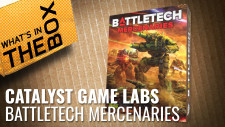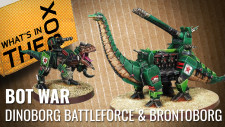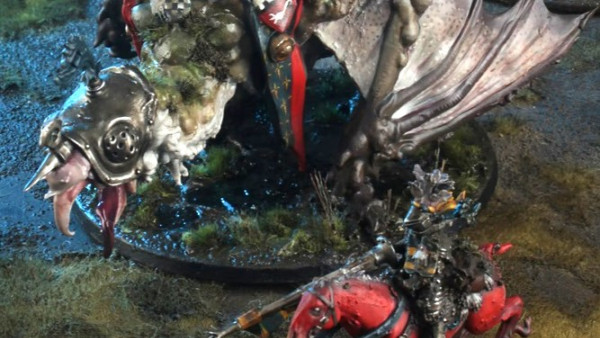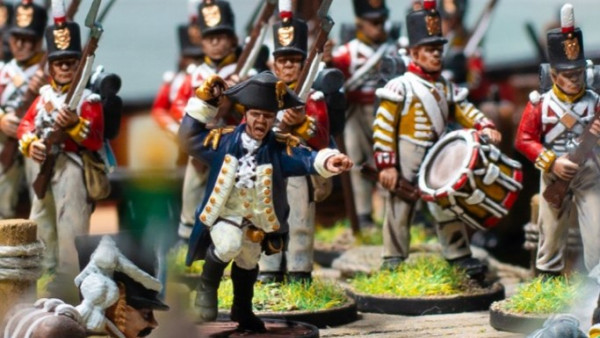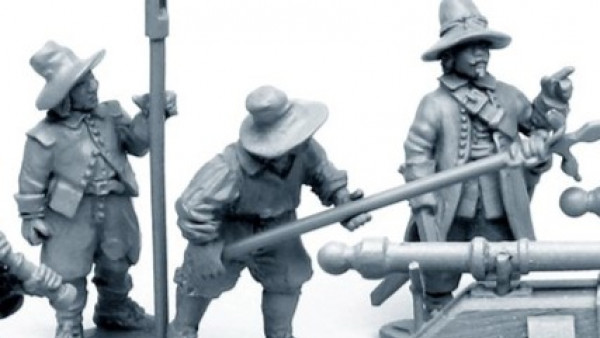Home › Forums › Historical Tabletop Game Discussions › Is the AWI best served with our current crop of rules?
This topic contains 30 replies, has 14 voices, and was last updated by ![]() wolfie65 2 years, 9 months ago.
wolfie65 2 years, 9 months ago.
-
AuthorPosts
-
May 21, 2021 at 3:44 am #1647873
Looking for some AWI rules. Problem I’ve had is I usually play refights of the historical battles using the OOBs and Unit strength of the day. However if the British troops are on the field they outperform the US troops to a point where we just can not get a US victory when they achieved it on the day (Usually the British and Hessians are “B” class and Guard ofc are “A”, while the best classification the US troops get “C” for the Continental Line Regts, every thing else is “D” or “E” class). There’s “something” about this conflict that all the rulesets we use just don’t reflect (and I’m finding it hard to narrow down what it could be, that allowed the US troops to win the day).
During the conflict each army also changed. When first raised the Continental Infantry weren’t issued with bayonets (nor were they drilled in their use), however towards the end of the war the Continental Infantry were just as happy to make a charge as their European brethren. Likewise the British (and European Troops) weren’t best able to tactically use their light infantry in a skirmish against Americans in rough terrain (they were drilled and expected to fight over an open field), and towards the end they had adapted to meet the challenge. The Milita were another aspect that doesn’t seem to be represented well, perhaps this is an aspect of “asymetric” warfare that isn’t covered. These men were hidden in plain sight, not in uniform (if locally raised, there WERE Militia Regts raised and outfitted in uniform in both sides that fought just like their regular cousins), so was there an impact of these men during the war that the rules just don’t cover?
At the moment we are using “British Grenadier”, which is a fine set of modern rules. But I’m wondering if it’s just reflecting the conflicts in Europe of the time better than the AWI (again this mysterious “something” is missing). Anyone got any ideas for some another set of rules that seem to reflect the AWI battles better than we been used to?
And don’t get me started on Gamers with a British army for this period who don’t have a single Loyalist Milita Regt in their Army (the vast bulk of troops on the British side were other Americans, after all the home depots for these Regts were an ocean away 🙂 ). Yet most battles we see being fought in articles all feature the British Guard (or Hesse Troops), we rarely see coverage of the US vs US battles that took place (we need to be educated away from the wargamer’s stereotype and have a bit more history injected into our games). Perhaps one of the reasons why we don’t see these battles is because the rules just don’t handle the period and Militia well?
May 21, 2021 at 5:36 am #1647875There’s “something” about this conflict that all the rulesets we use just don’t reflect (and I’m finding it hard to narrow down what it could be, that allowed the US troops to win the day).
Morale? Fatigue? Hunger? I guess there are many human factors that are hard to replicate because a) they weren’t documented well at the time when the battle happened or b) were documented false on purpose (for propaganda reasons for example).
But there is also possibility c) (and please don’t take this personal, but it happened to me more then once too) May you play the rules wrong? maybe you forget something or get the order in which things should happen wrong?
May 21, 2021 at 7:39 am #1647880This … is a tough one. Even as a guy who’s screen name is literally a Revolutionary War battle, I have struggled for decades with some of the same problems.
1) Rebels & Redcoats: Too complex.
2) Muskets & Tomoahawks: Too simple, and too small. And that whole “narrative system” for which it reaps so much praise is terrible when you’re trying to create a real event and thus dont need the narrative.
3) Anything Napoleonic: Too big. Also, the tech is off.I am not familiar with the British Grenadier system you’re talking about. I’ll have to research that. Trust me, like you… am I still looking. 🙂
Even when I sit down to design a game, I have issues.
Retooling of TSR Battlesytem 2nd Edition (believe it or not):

Battlefield: Rebellion, a company-scale (about 50 men to a counter) game we use sometimes.
 May 21, 2021 at 7:48 am #1647881
May 21, 2021 at 7:48 am #1647881Probably not so much a problem with rules, but a problem with lists. If you play with gamers who always want to play ‘the best’ then yes all those units are fielded. There were certain battles where on paper the Colonists had no chance, and that turned out to be the case. The column of elites, highlanders and lights was present in the South, but it was only one part of the army. I suspect they are the same players who play late war German Kampfgruppe with Tiger II, Pak 43 and diehard veterans.
Some rules also struggle because when it says battalion or company, then the notional rather than effective establishment is used. It’s not the notional 800 men present, it might be 300 or even 200 men.
British Grenadier isn’t a bad set of rules, it’s traditional in approach. Pick another battle, get the scenario right, and it should work.
I just play smaller scale skirmishes where it is easier to balance the forces or there can be asymmetric victory conditions.
May 21, 2021 at 7:51 am #1647882Given the big differential in troop class you describe I’m not surprised the Americans can’t win a game, all else being equal. Rules use class to cover the differences in quality and performance between troops and so create sufficient variation between forces to make a wargame less chance based. One way some rule sets try to even things up is with leadership classes that penalise poor commanders and give bonuses to good ones. I don’t play British Grenadiers so don’t know if this is part of the system.
If your historical refights can’t return the correct result on the day because of this rules imposed restriction then it needs changing. Not everyone is a fan of house rules but your situation seems ideal for it. I’ve played scenarios with temporary penalties or bonuses to class that are scenario specific. Milita units get +1 class and to reroll failed morale tests if they occupy their village, regulars get a morale penalty because they didn’t get paid or ran out of rations, local skirmishers get enhanced cover bonuses regardless of the terrain they occupy, etc. One set of rules that has a good period feel (although on a smaller scale) is Muskets and Tomahawks. I’ve not played AWI but plenty of FIW and the way they handle skirmishers and scenario based bonuses and penalties is excellent. They give a very good ‘period feel’ as far as our group are concerned. Regulr units are tough and if everything suits them (open terrain, clear lines of sight and room to manoeuvre) they are hard to beat but the game features boards that are busy with terrain and careful use of this and good coordination of your units can see them soundly beated by the locals.
May 21, 2021 at 8:05 am #1647884In an effort to be more helpful, let me try to address some of your questions:
I usually play refights of the historical battles using the OOBs and Unit strength of the day. – as God intended. 😀
However if the British troops are on the field they outperform the US troops to a point where we just can not get a US victory when they achieved it on the day. Yeah, here is a big issue. And again, I’m not familiar with the “Grenadier” rules you mention, it’s just a huge problem with any system or scenario that tries to faithfully recreate and American Revolutionary battle. The British are just too damned good. And most American regiments are just terrible, especially their militias.
We’ve been working with some very asymmetrical victory conditions. When I design a scenario, I try to measure as best I can what the actual results of the day were, carefully measuring time, distance, casualties, etc. That’s the “draw” line – if the game works out in a roughly equivalent manner, the game is a draw. The victory conditions demand that the Crown player do that, in that time, while taking that few losses, while inflicting that many losses, taking that many prisoners, etc. If they want to win, they have to stomp the rebels even HARDER than they did historically. If the Rebels can hold out just a smidge better than they did historically, they win the game.
Crude example: The Patriots had ten regiments on the day, lost nine of them. In the gamne, they lost only eight. They did better than the historical record. They win.
This kind of thing I find is a great equalizer. The Crown player suddenly has a huge burden of victory to carry.
And I’m sure you know this, because you sound pretty knowledgable on the topic … but many battles history records as Patriot victories … many wargames would consider a defeat. Examples would Breed’s Hill 1775 and First Freeman’s Farm (First Saratoga) 1777.
One thing many games get wrong is this: Yes, they get the British regiments right. But miss the fact that were almost always terribly understrength. They get the number of regiments, which regiments, all that right, and then put them on the table with full parade ground strength.
However towards the end of the war the Continental Infantry were just as happy to make a charge as their European brethren. This is Von Steuben’s training, mostly during the Valley Forge winter of 1777-78. But during most of the war, the British “cold steel” was always one of the more terrifying weapons on the field.
Likewise the British (and European Troops) weren’t best able to tactically use their light infantry in a skirmish against Americans in rough terrain (they were drilled and expected to fight over an open field), and towards the end they had adapted to meet the challenge. This is greatly expanded by Loyalist militias (as you mention) especially in the osuth, and Native American (Iroquois) warriors in the north.
The Milita were another aspect that doesn’t seem to be represented well, perhaps this is an aspect of “asymetric” warfare that isn’t covered. Arggh, now this is another tough one. “Militia” covers a lot of ground. Some militia, Patriot and Loyalist alike, were quite good. Much more if it was terrible. Then you get militia units that greatly improve as the war progresses and they get new commanders. A good example is the “Green Mountain Boys.” Under Ethan Allen at Ticonderoga, May 1775, they were little more than a drunken mob of bandits (sorry friends in Vermont). Under Seth Warner they were a solid outfit, and bloodied Fraser’s Advance Corps in a nice delaying action at Hubbardton (July 1777).
If you’re looking for something to reflect militia hiding in plain sight … i.e., local boys taking up arms … consider allowing some of them to deploy off of any table edge? I’ve seen people at conventions use hidden movement (several large tiles represent POSSIBLE locations of a militia force as it maneuvers … only as they appear and open fire are the tiles removed and the real minis put on the table). Maybe mix in some rifles (with their very hard-hitting abilities), since many of these militia are civilians with civilian hunting weapons.
Speaking of rifles, do the rules you’re using address this? In Battlefield Rebellion I wrote not only a range and accuracy effect, but also a morale and unit cohesion effect, since riflemen always aimed for officers (not commanders, but the lieutenants and NCOs mixed in with a typical Crown regiment). Units under rifle fire are almost immediately shaken or routed as the officers go down and there goes unit cohesion.
A lot of AWI games and scenarios put TOO MANY British grenadiers or light infantry on the table. One company of each was typically included in each regiment of 10 companies (as I’m sure you know). Over-representation of grenadiers and light infantry is something I’ve run across in some games.
And don’t get me started on Gamers with a British army for this period who don’t have a single Loyalist Milita Regt in their Army … it depends on the battle. And again, what we mean by “militia.” (like in the Northern Campaign it’s often Canadian Rangers or Iroquois natives). But yes, especially in the Southern Theater, Loyalist militia are a huge factor, and they’re just as unreliable as most state or Continental militia.
Great topic for a discussion.
May 21, 2021 at 11:53 am #1648016@oriskany Well here’s a review of the rules (although he only played one game), that give you the general gist of things…
The Road to Yorktown: British Grenadier – A First Impression of the rulebook
I’ve no problem with “old skool” rules (usually meaning casualty removal, figure frontage, formations and troops being deployed at a figure ratio rather than a generic “lump” as is the trend with historical rules of late). These I’ve personally found to be the “best of the rest” when it comes to rules for the conflict (but still not giving me what I want for refights, perhaps house rules is the only way to go). It’s a much ignored period when it comes to historical gaming, and I think in part this is due to previous rules for the periods inability to reflect the conflict very well (most AWI rules are hybrid with the 7YW conflict which tactically was a different kettle of fish)
@khusrau Yep, the problem is when we try to do a refight and loyalist militia are on the field. Our two British generals have loads of British and Hesse Troops, but only ONE loyalist Militia painted up (and that’s only because the Colonel for the unit has the same surname as the gamer in question). And perhaps it’s just a coincidence, but they BOTH do have WW2 German Armies 😀 (1 SS and 1 Paratroop for BA). Personally I’ve got Early War Russians in 15mm (perhaps I’m drawn to crap Armies along with the Continental Side in AWI). Thankfully British Grenadier DOES have a figure ratio, and you can field unit sub strength (as Oriskany pointed out), but it’s getting harder and harder to find OOBs these days online with unit strengths (as most modern rulesets ignore this).
@zoidpinhead Yep, looks like “house ruling” British Grenadier is going to be the way to go. It’s a pity there isn’t a ruleset out there that simply does a GOOD job for reflecting the AWI (I’ve personally found Johnny Reb II to be the BEST ACW ruleset out there (if you can live with the little green counters everywhere), and wouldn’t change for another set. The Terrain for AWI is an important aspect, as the US troops were happy to fight within wooded areas/rough terrain, whereas the British commanders were trained (and expected to fight) across an open field. This meant they usually did their best to stay well clear of such obstacles as they had a detrimental effect to command and control (yet hardly any rules reflect this, even with Napoleonic games we see “firebases” of troops in Villages (when historically they tended to keep clear other than a few exceptions like Hougomont at Waterloo)) .
Thanks for taking the time to reply Gents, I guess the search goes on……
May 21, 2021 at 2:48 pm #1648116I enjoyed British Grenadier when I’ve played them. I think there is a 2nd edition now
May 21, 2021 at 4:12 pm #1648185I actually think Sharp Practice, although intended for low level skirmishes works very well for AWI. Simply treat as 1:10 scale and each group is then a company equivalent. There were lots of engagements at this scale and with hugely understrength battalions, 4 groups gives you a British battalion of 320 men. We played a fun multi player Battle of the Cedars with SP. The other rule set that worked for large engagements in 6mm was bizarrely ‘Horse, Foot & Guns’.
When I was looking for a set for AWI, British Grenadier was the most recommended to me, and I have a copy, but have never got to play it.
May 21, 2021 at 5:09 pm #1648202Interesting points, @khusrau . I don’t know much about Sharp Practice.
If one has to use a Napoleonic system for appoximate the American Revolution, I would agree that something designed for the Peninsula Campaign is a good place to start. The average size of the battles were much smaller. British forces were strictly limited given the demands of the wider conflict (as British forces were badly limited in America) and working with unreliable allies (as they were in America). Spain and Portugal in those days were in general not as highly developed infrastructure-wise as other parts of Europe (like America was certainly) and of course we have a lot of irregular militias, guerrillas, etc… adding another approximate parallel.
I do start to grow wary when it comes to “variable scale” when it comes to units – I feel its a widespread blight infecting most of today’s gaming releases. I understand companies want to make their games inclusive, etc. etc. But it also slews the the real-life interrelationships between the size of the unit, movement, weapons ranges, density of firepower, etc., and thus the tactics and counter-tactics that rely on these factors.
Making one man now equal 10 men … do we reduce the range accordingly? I’m not saying that making 1 man = 10 men means we should you reduce the musket ranges by a factor of ten, but maybe by a factor of two or three (based on lines would fire in two or three ranks, depending on the regimental model being employed).
How about marching speeds? Movement might also be reduced a little because ten men, of course, do not move at the same speed one man does. Not when a sergeant has to take orders from a lieutenant, then relay those orders, form the men, march the distance, redeploy in line, and then presumably deliver fire. When it’s one man, he just starts hoofing it without all these associated procedures.
This make sound like nitpicking, but I feel it comes into play when, say … unit “A” has to cross “X” distance to deliver a bayonet charge against Unit “B,” while taking “Y” fire over “R” range for “Z” time … Whether that unit has to endure one or two volleys of counterfire makes a huge difference, and the root of that solution is going to lie in those relationships between time and distance and scale.
All that said, I’m sure the proposed solution would work well enough. The American Revolution was a delightfully disorganized conflict, and I feel an approximate skirmish system would work well enough, so long as you’re not doing larger battles like Long Island, Monmouth, or First/Second Freeman’s Farm.
And damn, the recommendations keep piling up for British Grenadier. I am definitely looking out for this one now. Like I’ve said earlier in the chat, I’ve been looking for a solid system for a while now. Seems to have a few small issues based on what people are saying, but these might lie in list / scenario design rather than the system itself.
May 21, 2021 at 5:18 pm #1648206Have you come across Rise and Fight Again by Stand To Games at all? (https://standtogames.co.uk/shop/ols/products/rise-and-fight-again-rules). I enjoy their Napoleonic ruleset (Over the Hills), but haven’t tried the AWI version.
May 21, 2021 at 5:36 pm #1648209I agree, if you are scaling the figure scale up then ranges should come down, which then changes the relationship between manoeuvre and firepower. (It makes me cry when I see ancients rules where units purporting to be entire 1000 man formations can shoot the same 24 inches). Sharp Practice uses variable movement and you can move faster if you are happy to accept some disorganisation (shock) or your leaders are using their influence to step up the pace (Stepping out). British formations want to reserve their fire to get the benefit of a crashing volley at close range, aimed fire is slower but more effective, untrained or undisciplined units are likely just to keep firing unaimed into the smoke and militia riflemen are a damned nuisance, being much more likely to hit leaders with adverse effects on morale and the ability to control formations.
There’s a small skirmish report here:
http://thetacticalpainter.blogspot.com/2020/09/coming-to-grips-with-sharp-practice.html?
May 21, 2021 at 5:42 pm #1648210What about Volley and Bayonet
May 21, 2021 at 9:53 pm #1648252@scribbs Thanks for that recommendation, I’d never heard of this set of rules. You generated a sale (and I got the last one), and they look interesting as well as being a Battalion level game (which is the Wargame rules “level” that I enjoy the most).
May 21, 2021 at 10:13 pm #1648253 -
AuthorPosts
You must be logged in to reply to this topic.



































